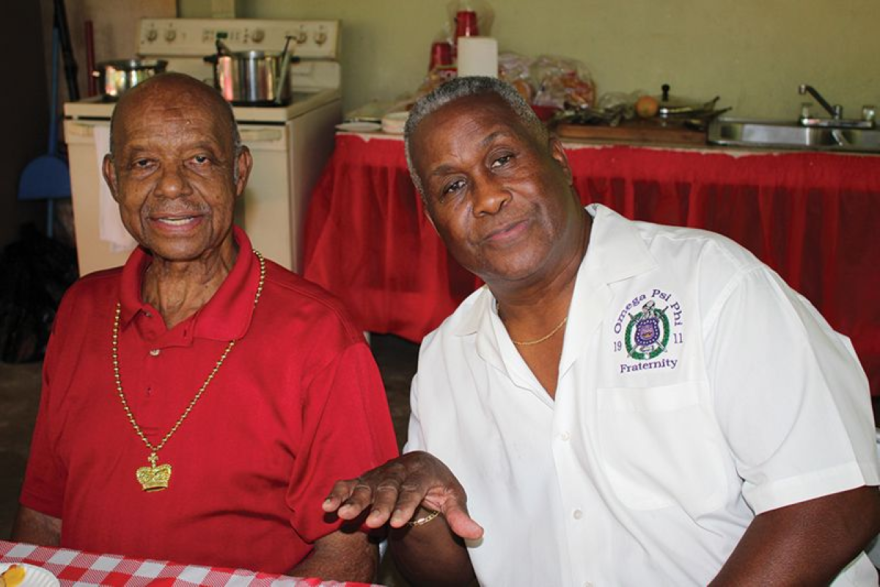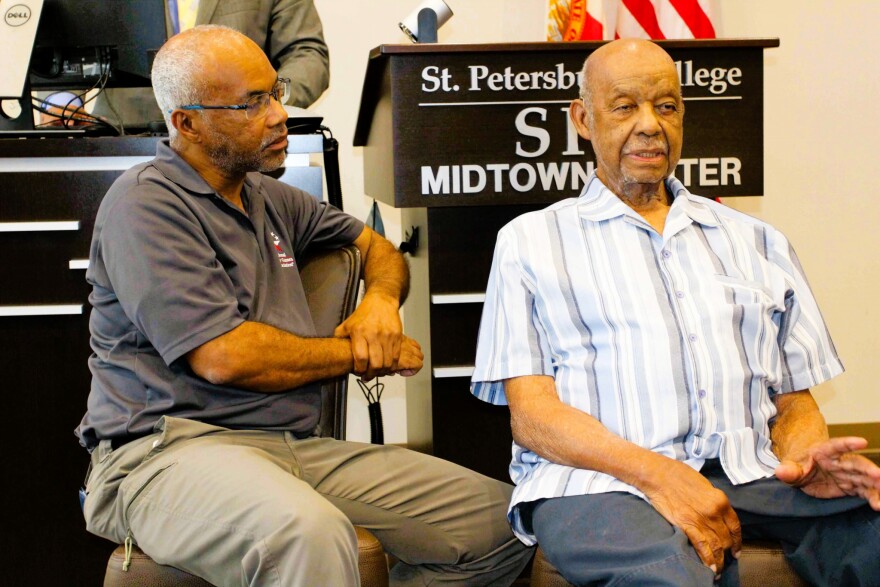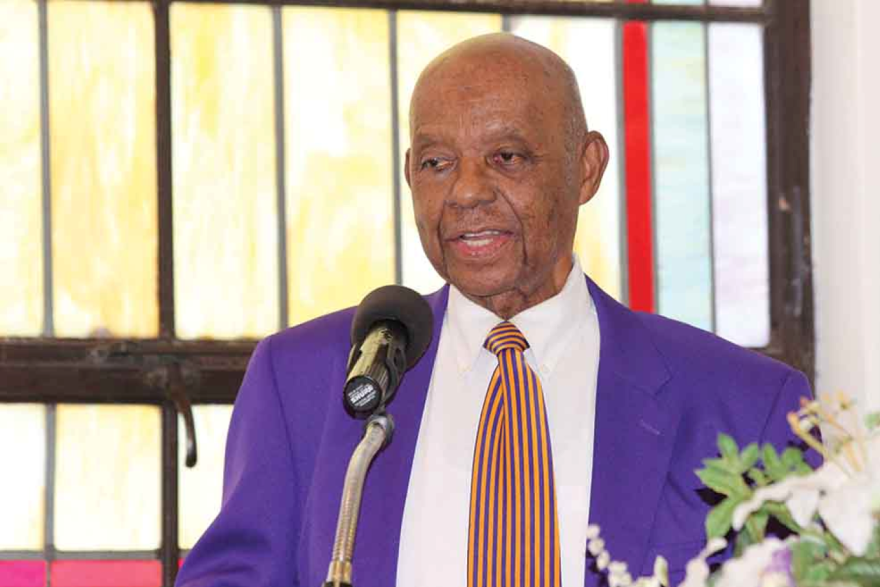With a mind like a steel trap, Mordecai Walker documented his remarkable life story and received his roses before closing his eyes in death on Sunday, August 17. He left the community with a treasure trove of historical accounts and a splendid example of how to live one’s life.
From almost being eaten by an alligator as a baby to diversifying his portfolio at age 13 by buying land, to meeting First Lady Eleanor Roosevelt and serving in the Pacific during World War II, there was little that Mr. Walker had not done in a life that spanned more than a century.

Born on July 4, 1924, Mr. Walker grew up in Citrus Park, about 20 miles northeast of Tampa, where he attended segregated schools. By the time he was the ripe old age of six, he took his first paying job working on the farm of a prominent white family.
“I’d leave school; I’d come home and change clothes and go right to Mrs. Singletary’s where I could make 15 cents,” said Mr. Walker in an interview with StoryCorps in 2022.
The farm owner gave young Mordecai a red coleus plant, which he quickly placed in a bucket with cow and chicken manure and grew into a prize-winning display at the 1931 Florida State Fair in the Negro Exhibition, a category that encompassed all aspects of Black life. His plant was entered under horticulture and won the blue ribbon, which garnered $5.
Young Mordecai gave his sister $2.90 for a school workbook and pocketed the rest, thus beginning his long career in horticulture.
At the age of 13, he was able to invest in his first piece of property. While working for a real estate investor, he was paid $1.50 a day to help clear land. His employer would pay him 75 cents and put 75 cents towards land for him. Not until after WWII did he finish paying off the property, which had gone up considerably in value.
Going to college, going to war
After graduating high school in 1943, Mr. Walker attended Bethune-Cookman College, where he met then-First Lady Eleanor Roosevelt and champion of education Mary McLeod Bethune and “got a chance to shake both of their hands,” he revealed to St. Petersburg College students in 2022.

However, as the war raged on in Europe and the Pacific, he was drafted into the U.S. Army, which put his education on hold. Mr. Walker took his basic training in Virginia, and at times realized that growing up in the country would come in handy. One day, he and his fellow soldiers had to hike about a mile and a half and cross a creek to reach their bivouac. When all the others slogged through the water waist-deep to get to the other side, he deftly jumped from “log to stump to log” until he made his way across.
“I was the only one who wasn’t wet!” he quipped.
It is no surprise that Mr. Walker knew his way around logs, as his father (Charles Walker), a lumberman and machinist, had helped clear the land on the Tampa side to construct the Gandy Bridge. Growing up in rural Hillsborough near a lake, he found that his family was never far from wildlife. One day, when his mother was checking her fishing line in the lake, she had a run-in with a scaly Florida native.
“An alligator came out of the lake and went in the house,” he said. “[When] she got back in the house, the alligator was standing up on his tail looking over in the baby bed!”
His mother (Pearl Walker) threw fish at the intruder, who went back out the door with his prize. The family decided to move the next day, “a long way from the lake,” he said.
But no matter how far Walker’s parents moved, they could not escape Jim Crow, particularly the sickening practice of gator baiting. Mr. Walker explained that a couple of white alligator hunters approached his parents about using their children as bait for gators.
Alligator hunting began in the 18th century and was very profitable, as the skins were used to make shoes, bags, belts, and other items. Many hunters lost arms and sometimes their lives in the pursuit of riches, so the practice of tying a rope around an enslaved child’s waist and placing them at the lake’s edge to attract alligators became common practice. The hunter would pull the rope before the alligator was able to grab the child and shoot it in the head.

After seeing young Mordecai and his siblings, they were deemed not dark enough to use.
“There was none of us really [dark]. You know, they were looking for real black [children],” Mr. Walker said. “My mother wouldn’t have done it no way, but we weren’t [dark] enough.”
Alligator baiting was still being practiced in the 1920s and possibly through to the 1940s.
Serving in the Pacific Theater in New Guinea, Sergeant Walker corresponded with pen pals back in the United States, who wrote to boost soldiers’ morale. One of them sent him a pamphlet for Tennessee State University, and when Mr. Walker got out of the army, he decided to resume his education at TSU.
Taking writing courses, he wrote a prize-winning essay that answered the question of who was more popular, Jackie Robinson or Joe Louis. Mr. Walker eloquently opined that although Robinson had broken the color line in baseball, he was a member of a team, while heavyweight boxer Louis was the sole champion of the entire world. Mr. Walker’s prize was a coveted ringside seat to the 1947 Joe Louis vs. Jersey Joe Walcott fight in New York, all expenses paid. After the fight, he had the opportunity to meet Louis, and the following year, he sat in the stands and watched Robinson play.
Mr. Walker pledged to Omega Psi Phi Fraternity at TSU in 1950 and would go on to become one of the seven founding members of the Eta Rho Chapter in 1962. He eventually served as chapter president from 1991-93 and never missed a meeting until his health would no longer permit it.
After graduating from college in 1951 and finding temporary work in Clarksville, Tenn, Mr. Walker returned to Florida to teach at Simmons Elementary School in Plant City and later Middleton High School in Tampa, where he was a driving force in establishing the agriculture program. He played a pivotal role in developing a curriculum and securing funding sources to bring the program to fruition.
In 2015, he noted that for Black college graduates, the options were limited at the time — most could only become doctors, lawyers, or schoolteachers for their communities. Often, Mr. Walker said, Black educators had to pay to secure jobs. When Mr. Walker refused to pay for a job on principle, he said he didn’t work for three years.
Life in St. Petersburg
Mr. Walker came to St. Pete in 1958, the same year he married Anna Marie Polk. He met her as a young man working in Hillsborough County. He recalled their first date, for which he had donned boots, Levi’s jeans, and a Stetson hat. Once they got in the car, Polk turned to him, apparently appraising his outfit, and asked him if he had any money. Young Walker learned he was sorely underdressed and would have to rectify the situation to take Miss Polk out again.

As an educator, he made the rounds in Pinellas County Schools, teaching at each school for about four years. He worked at Perkins Elementary, Lealman, Northeast High School, Sixteenth Street Middle School, and Southside when it was a junior high housing grades seven, eight, and nine.
Walker remembered Southside as the first school in Pinellas County to integrate. Although the act of eliminating segregation in schools was not an easy task, Walker did not recall any issues.
“They bused the kids from Coquina Key, the white kids,” he recalled in an interview in 2015. Mr. Walker revealed his secret to making the integration a success.
“I didn’t bring any problems to class,” he asserted. “I didn’t have no hang-ups.”
Although he enforced school rules, Mr. Walker felt he was more laid back than some, recognizing that students were there to learn, not to spend their time in the office dealing with disciplinary issues.
“If I see a kid chewing gum, they took it out,” he explained. “But some teachers, they’d write a referral and send them to the dean.”
He began as a fourth-grade teacher but soon discovered his true calling — agriculture. He continued the program he had implemented in Hillsborough and took it to each school where he taught.
Mr. Walker remembers the teacher walkout that took place back in 1968, which he said lasted for roughly 28 days. “I spoke against walking out,” he said, citing that teachers had just signed a contract and were set to see a raise in their paychecks. However, a few months later, he stated that the executive secretary of the Florida State Teachers’ Association had called for a strike.
“And the thing about it was he didn’t have something definable like more money or less work,” recalled Walker, who said the reason stated to him back in the day was to gain a quality education.
“Today, nobody still knows what quality education is,” he laughed.

Mr. Walker was also a member of the Ambassadors Club, an influential group advocating civil rights that was founded in 1953 by civil rights leader Dr. Ralph Wimbish. The club hosted events featuring prominent keynote speakers and presented a Citizen of the Year award.
“It was a civic club,” Mr. Walker explained, “and the philosophy was that we didn’t want to destroy nothing or change nothing, but how can we better work in the system that we already have.”
Although the organization became inactive in 2004, Mr. Walker recalled the group ensuring that Black children never went hungry at school, always providing funds for them to eat.
“At that time, there was no free lunch; that was before integration,” said Walker. “We did some great things.”
Displacement from home in the Gas Plant
The Walker family is one of hundreds of families displaced from their homes due to the construction of the highway and what would eventually become a baseball stadium. The year was 1979, and Mr. Walker was told he’d have to leave his home.
The City of St. Petersburg offered the Walkers only $43,000 for their four-bedroom, three-bath home. Although their home was worth more, Mr. Walker was told that he “overbuilt” for the area. With the help of a certified public accountant, he was able to secure an additional $15,000 and retain the salvage rights.
Mr. Walker was also a member of the finance committee at First Baptist Institutional Church, which was also being displaced. As a real estate agent, he helped the church find a new home and used the commission to help buy his family their forever home.
Later years
After Mr. Walker retired from the school system in the late 1980s, he continued selling real estate and did other jobs that interested him. Even after his wife of 50 years passed away in 2008, he continued to stay active in the community.

He would don his purple Omega Psi Phi Fraternity jacket while speaking at various engagements and collecting a house full of awards and honors, such as his induction into TSU’s Agriculture Hall of Fame for his over 30 years of service to advancing the field of agriculture in education. The induction into the City of St. Petersburg Senior Hall of Fame for his volunteer service to help improve the quality of life for the residents of St. Petersburg, and the induction into the Congressional Record by U.S. Rep. Kathy Castor.
When speaking to younger generations, he frequently told them to look ahead.
“Be concerned about your future because that’s where we all must spend the rest of our lives — in the future,” Mr. Walker said in a 2015 interview. “And try to improve it.”
Mr. Walker is survived by his sons, Andrew Walker of St. Petersburg and Edward Stevenson of Nashville, Tennessee. Left to cherish his memory are a host of adoring relatives and friends, the Eta Rho Chapter of Omega Psi Phi Fraternity, and the thousands of St. Petersburg residents whose hearts he touched.
Mr. Walker’s wake will take place on Friday, Sept. 5, from 6-7 p.m. at Sanchez Rehoboth Funeral Home, 6501 25th Way S, St. Petersburg. The funeral will be held on Saturday, Sept. 6, at 11 a.m. at Mt. Zion Progressive, 955 20th St. S, St. Petersburg.
To listen to and read more about Mordecai Walker’s extraordinary life, click the following links:
StoryCorps Archive January 14, 2022
StoryCorps Archive January 29, 2022
StoryCorps Archive February 2022
The life and times of Mordecai Walker



